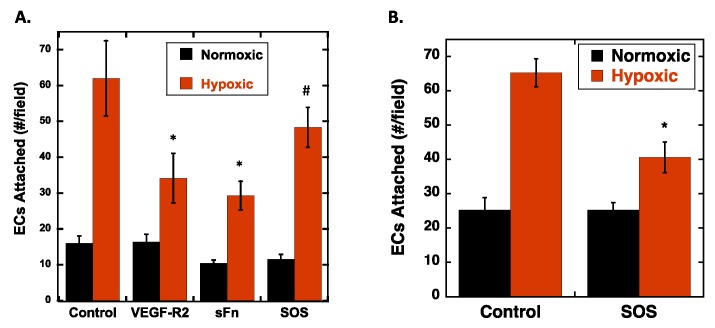Figure 2.
Soluble VEGF-ECM (vascular endothelial growth factor-A-extracellular matrix) Antagonists inhibit endothelial cell attachment to hypoxic RPEs. (A) RPE cells were subjected to normoxic (20% pO2) or hypoxic (1% pO2) conditioning for 48 h. Fluorescently labeled REC were allowed to attach in the presence of the indicated soluble effector: Fc-VEGFR2 chimera (100 ng/mL); soluble 40 kDa Hep2 domain of Fn (10 µg/mL); and sucrose octasulfate (SOS; 100 µg/mL). After the attachment period, the cells were washed, fixed, and counted (n = 4 fields/well; N = 3 wells/condition). The data is expressed as the average number of attached cells per field ± SEM. * ANOVA followed by Turkey’s tests revealed that hypoxic versus control, and Fc-VEGFR2 chimera and sFn on hypoxic cells versus hypoxic cells were statistically different (p < 0.05), # hypoxic control and SOS on hypoxic cells were not statistically different (p = 0.08). (B) SMC were subjected to normoxia or hypoxia for 48 h and REC were allowed to attach for 1 h in the presence and absence of SOS (500 µg/mL), and fluorescent cells counted as described above. Hypoxia significantly increased REC attachment to SMCs compared to normoxic cells, and (*) SOS significantly inhibited SMC attachment to hypoxic cells (N = 3; n = 4) (p < 0.05).

